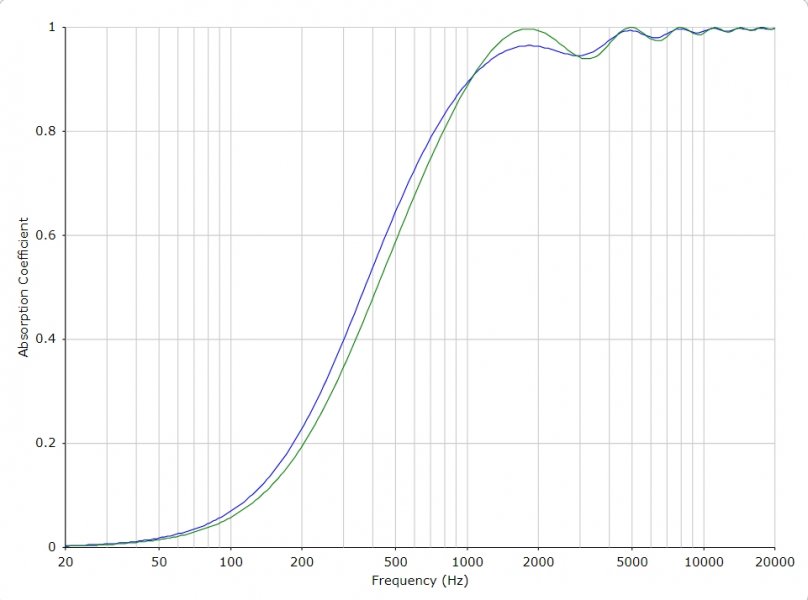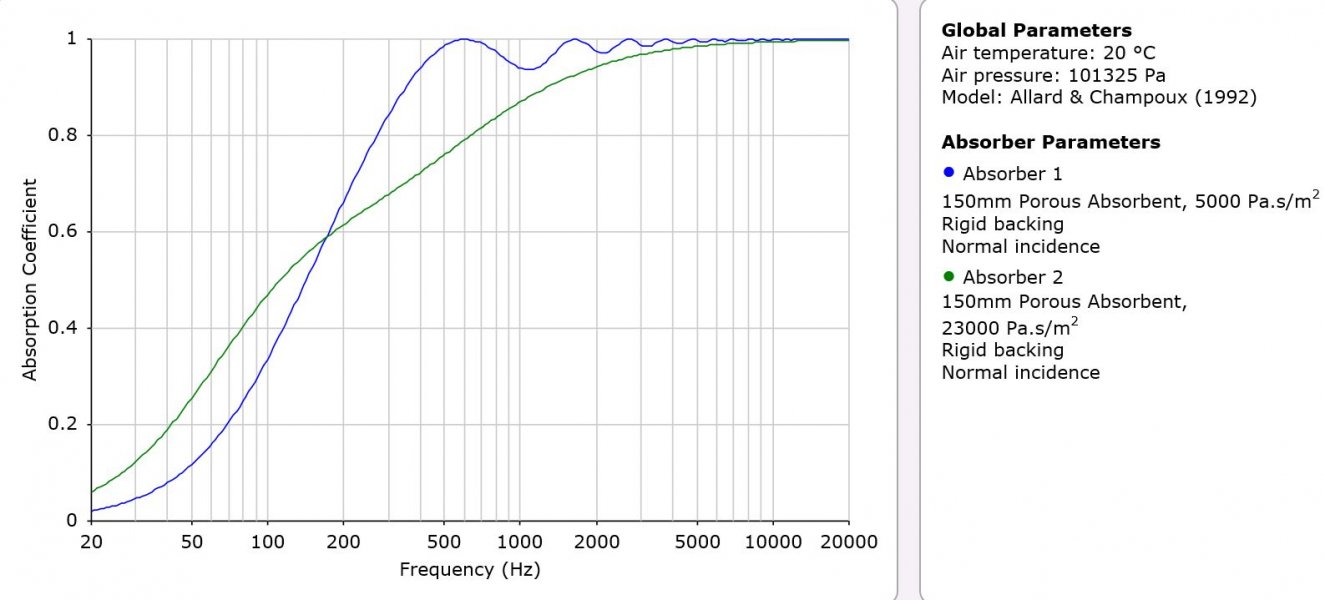The argument for/against room treatment
- Thread starter MadFloyd
- Start date
You are using an out of date browser. It may not display this or other websites correctly.
You should upgrade or use an alternative browser.
You should upgrade or use an alternative browser.
Peter
would you mind adding the distance to side wall from speakers and listening distance from speakers to the above dimensions ..... I am a big fan of far away from sidewalls as possible and you are clearly happy with the current set up - I apologise if you have already set this out elsewhere - I presume you have speakers on the slightly shorter wall
Phil
Hello pjwd. The speakers are on the slightly longer wall. Each tweeter is 51.25" in from the side wall. They are aimed straight ahead. The tweeters are 9'-3" from each ear at the listening seat which is centered about 14" from the rear wall.
SbnxHere is my understanding of how this works.
Bouncing the sound off the sidewalls will give a bigger soundstage because the delay in arrival times pulls the image toward the reflection. If we do this to both walls then the soundstage is wider. In order to do this without serious sonic malady two conditions need to be met. 1. The time delay between the reflection and the direct sound needs to be at least 5-6 ms. If the sidewall time delta is >10ms then untreated walls are fine and probably preferred. If the time delay is less than 5ms and the walls are untreated then the imaging is going to suffer and the sound gets "pingy". 2. The speaker off axis response should be smooth and generally the same as the on-axis response. If this is not the case then the timbre of the instruments will be shifted.
This is why I think there is general disagreement on whether people think the first sidewall reflection should be treated. If two people have the same speakers and one person has them in a room that is say 14' wide then he/she will probably prefer to treat the sidewall. The other person has a room that is 20' wide then he/she will probably prefer not to treat it. Now mix in that the second person has a speaker with really bad off axis response then he may also prefer to treat the sidewall if he/she is really tuned into "tone & naturalness" vs. maximum soundstage width and spaciousness.
Sometimes compromises have to be made. What is important? Spaciousness & Soundstage? Precise imaging? Tone & timbre?
I am not sure that is the case .. speakers well away from side walls can image well and give a large soundstage
I believe the soundstage is baked into the recording and speakers with good off axis behaviour reproduce it
I should add that ideally the delayed reverberant field is correlated with the directsound and provudes a nice even decaySbnx
I am not sure that is the case .. speakers well away from side walls can image well and give a large soundstage
I believe the soundstage is baked into the recording and speakers with good off axis behaviour reproduce it
PeterHello pjwd. The speakers are on the slightly longer wall. Each tweeter is 51.25" in from the side wall. They are aimed straight ahead. The tweeters are 9'-3" from each ear at the listening seat which is centered about 14" from the rear wall.
This is amray trace a free online program - it allows you to click on a path and shows you the time delay with direct sound - that's the bar down the bottom - it shows your first side wall reflection about 4.7 ms delay - which is short but not too shabby - the ones before and after are from rear wall close to your seat and after that you are out to the 8ms zone or so
a high back seat and a couple of pieces of sculpture either side
I also sit quite close to the rear wall - it is actually a pair of sliding doors and I expected a massive difference between open and closed but in reality it is only slight - perhaps because of my chair - its an Eames aluminium group lounge with the high back
Of course it may be just my head and ears blocking it
my room is similar front to back as yours but 23' wide - I recently relocated the speakers to long wall and it was a great improvement - I am now building the acoustic equivalent to your fire place between the speakers
its all very interesting to see what folks are getting good results with
Cheers
Phil
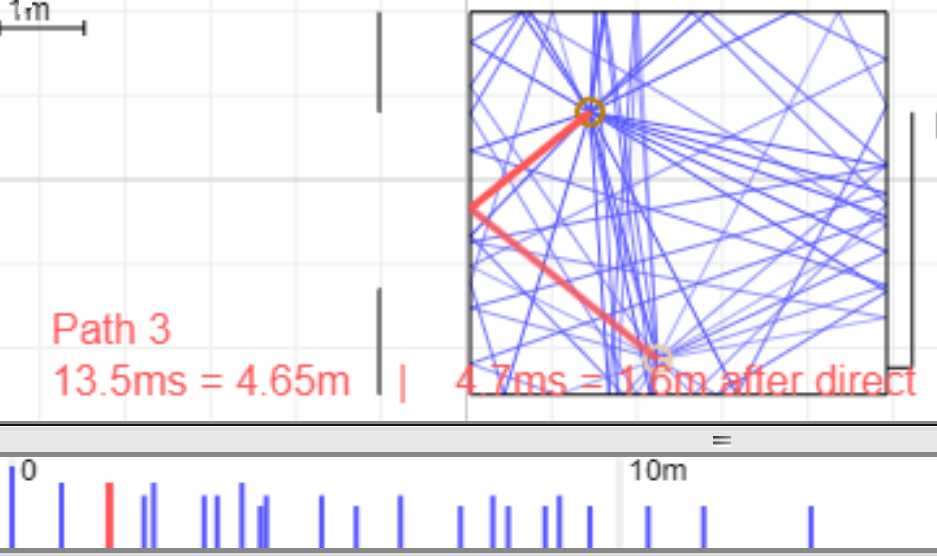
Bruce B
WBF Founding Member, Pro Audio Production Member
This is why I chose some of the best off-axis performing speakers available.Duke covered this just a couple posts before. It's the main reason Toole/Harman think having smooth off-axis response is top priority. IMO the polar map is the best way to visualize this...
Lemme guess. Ummmm, pure evil?
Indeed the cacophony of waves would be most detrimentalLemme guess. Ummmm, pure evil?
The darkened area at that spot shows not the same color intensity as the waves crisscrossing fore and aft of said occupier.
Looks as if they may be leaving the listener with just the direct sounds and infinite reflections.
Interesting
BruceD
The idea that you don't need any side wall treatment is related to studies where having speakers that measures very well off-axis combined with sufficient distance to side walls, increases spaciosness and can be beneficial compared to treatment and absorption. But these studies are quite inadequate in several ways.
First of all they are not very conclusive, especially when it comes different music genres. It's mainly classical where late side wall reflections have been found to be preferred.
Secondly they don't take into the account how the rest of the room is treated. For example: Spaciosness can also be added with late arrival diffuse energy. These rearechers haven't explored different kinds of acoustic principles at all. And obviously in most homes there isn't a pefect reflective wall on both sides but there will often be furnitures, pictures, windows, etc. that creates a much different and complex impedance surface.
Thirdly, these studies don't really say anything about people prefer over time. Personally I've found that what I prefer in a short listening test, may not be the same as over time with different music material. Sometimes it can be impressive to have reflective side walls, but it get's fatiguing over time.
When it comes to bass trapping, there's basically no reason why that shouldn't always be better as long as they don't overdampen mids and highs.
Take note that reverberat time does not exist in small rooms. We need to apply other methods in these types of rooms. FIY: I work in the area of acoustics and small room acoustics is my expertise.
First of all they are not very conclusive, especially when it comes different music genres. It's mainly classical where late side wall reflections have been found to be preferred.
Secondly they don't take into the account how the rest of the room is treated. For example: Spaciosness can also be added with late arrival diffuse energy. These rearechers haven't explored different kinds of acoustic principles at all. And obviously in most homes there isn't a pefect reflective wall on both sides but there will often be furnitures, pictures, windows, etc. that creates a much different and complex impedance surface.
Thirdly, these studies don't really say anything about people prefer over time. Personally I've found that what I prefer in a short listening test, may not be the same as over time with different music material. Sometimes it can be impressive to have reflective side walls, but it get's fatiguing over time.
When it comes to bass trapping, there's basically no reason why that shouldn't always be better as long as they don't overdampen mids and highs.
Take note that reverberat time does not exist in small rooms. We need to apply other methods in these types of rooms. FIY: I work in the area of acoustics and small room acoustics is my expertise.
I would like to share an acoustic experiment I performed. I had may speakers and listening position such that the reflection from the side wall was about 7ms later than the direct sound. I played John Campbell's version of "Down in the hole". This is a pretty open and spacious sounding recording. I then placed a 2'X4' sheet of 2" thick OC703 at each of the sidewall reflections. I asked my spouse to listen and comment. I asked her what she thought when I put the panels in place. She said "Its like the sound just got all concentrated in the middle between the speakers". Her way of saying that the soundstage collapsed.
All I can say is that acoustic treatment is not all that expensive. Get a couple panels or make your own and experiment. If you like what it does then that is great. If not you are only out a couple hundred dollars. (Much less than the depreciation hit you just took when you sold that pair of cables for a different pair)
As a note: my room is dedicated, highly symmetric and well treated. My speakers have very good off axis response.
All I can say is that acoustic treatment is not all that expensive. Get a couple panels or make your own and experiment. If you like what it does then that is great. If not you are only out a couple hundred dollars. (Much less than the depreciation hit you just took when you sold that pair of cables for a different pair)
As a note: my room is dedicated, highly symmetric and well treated. My speakers have very good off axis response.
The idea that you don't need any side wall treatment is related to studies where having speakers that measures very well off-axis combined with sufficient distance to side walls, increases spaciosness and can be beneficial compared to treatment and absorption. But these studies are quite inadequate in several ways.
First of all they are not very conclusive, especially when it comes different music genres. It's mainly classical where late side wall reflections have been found to be preferred.
Secondly they don't take into the account how the rest of the room is treated. For example: Spaciosness can also be added with late arrival diffuse energy. These rearechers haven't explored different kinds of acoustic principles at all. And obviously in most homes there isn't a pefect reflective wall on both sides but there will often be furnitures, pictures, windows, etc. that creates a much different and complex impedance surface.
Thirdly, these studies don't really say anything about people prefer over time. Personally I've found that what I prefer in a short listening test, may not be the same as over time with different music material. Sometimes it can be impressive to have reflective side walls, but it get's fatiguing over time.
When it comes to bass trapping, there's basically no reason why that shouldn't always be better as long as they don't overdampen mids and highs.
Take note that reverberat time does not exist in small rooms. We need to apply other methods in these types of rooms. FIY: I work in the area of acoustics and small room acoustics is my expertise.
I agree. IMO the preference testing for this, as well as just in general, has a lot of issues and I believe they have reached some questionable conclusions as a result. I don't think it's worthless, but as you said, there are issues.
Stehno, I'm intrigued by your ability to play your system at an average of high 90's to low 100 dbs (if I have that right?). There is no way I could do that in my system from a 10' listening position -- maybe for awhile further back in the room (35') where I often listen while working, but I think it would over pressurize my room not to mention my second favorite organ -- my ears.Indeed needing some form of room treatment is the long-standing rumor. From a common sensical perspective, I'd imagine that walls, floors, and ceilings will interact or "interfere" with any sound generated live or playback. It is the nature of sound and acousics. Whether it be a football stadium, a large gymnasium, a 2-car garage, or a walk-in-closet.
Again, that is the long-standing rumor but perhaps it's not a rumor for some as I'm confident this so-called need for room treatment is dependent entirely on a given playback system and its level of musicality / resolution. If such a need exists at all, then it must be for playback systems that are not very musical / resolving.
Moreover, when a playback system is not very resolving it makes little sense to me to turn one's attention toward room acoustics when clearly attention is needed for the playback system. In fact, I get the impression many would rather spend their resources on the effects rather than the cause.
But such statements should include some qualification as it was already expressed that every last room is already "treated" to some degree, even if it only has carpet and pad. It's slightly more treated if a chair and ottoman is installed, etc, etc. So perhaps the term "room treatments" needs some sort of qualification.
Other concerns when discussing room treatments might include:
1. Every room is different and will sound different.
2. Every speaker is different and will sound different.
3. Every room/speaker combination is different and will sound different.
4. Listening volume levels. Seems like there's plenty who prefer elevator music volumes levels in which case not much of anything really matters. At the other end are those like me who prefer listening at or near live music performance levels and if room treatments were the bees knees, it should be for these type. Regardless, it helps to know when somebody comes from these perspectives.
5. Everybody has different levels of hearing abilities as well as different abilities to discern / interpret what they hear. For example. One with a touch of tinnitus in one ear might overly complain about certain torturous music pieces breaking up or flattening out on that side of the room or from that speaker. Another example could be someone claiming to be hearing first reflections from certain points and it's entirely possible they are speaking inaccurately.
6. Like fingerprints, no two playback systems will ever sound identical. Even if the 2 systems are identical in every way and perhaps if they were set up in identical rooms and identical positions.
7. At least for the lower frequencies and superior bass, speaker positioning is absolutely paramount. Not everybody gets this and those that do get this will get this to varying degrees.
8. The one concern that nobody seems to mention is a given playback system and it's level of musicality / resolution and how it may factor into any such supposed need.
9. Perhaps as important as any is speaker placement and how inferior positioning of a speaker can wreak havoc on the bass as well as the overall playback presentation.
Anyway, I would think for anybody to be even close to being on similar pages or at least for those who swear by "room treatments" and/or custom rooms at least some of these variables / qualifiers should be important considerations. Especially in audio forum threads where others cannot hear what we hear, yet I rarely if ever hear anybody discuss any of matters like these. At the very least it would serve us well to consider qualifiers like these and others important variables if one deems room acoustic treatments as a requirement. Hopefully nobody is saying with regard to treatments that one size fits all. If the solution is variable then why isn't the need variable too? Instead, we just have others like yourself saying it's a requirement. Period. And not taking into consideration any very real and potentially significant variables almost as if these variable have no impact.
In contrast, I've focused all of my time and attention toward dealing with the cause rather than the effects, so I really don't have any such concerns. Hence, IME the need for room treatments in a reasonable room or even the need for custom rooms that include room treatments is for the most part fallacious if not downright folklore. That's not to say that a little treatment here or there to better tune a room isn't worthwhile but even that's a far cry from an absolute requirement.
----------------------------------------------------------------------
I'm compelled to ask those who think room acoustic treatments / custom rooms as a necessity. Is it at all possible that room acoustic treatments in general don't actually make a playback system hence its playback presentation more musical (how could they?), but rather they only make an already less-than-pleasing playback presentation less fatiguing / more tolerable / more pleasing? That's my hunch. And if possible, might not such a strategy be kinda' bass ackwards?
The last amplified concert I went to last year in a mid-sized club, was in the the 95-105 db range and while the sound quality was pretty good, it just felt like a damaging assault on my ears after awhile (and this was with ear protection).
So if you've managed to listen to reproduced music in a small room at those constant levels without doing serious damage to your hearing, and it sounds good, you've pulled off a miracle.
Yes. It's best to experience this rather than simply concluding based on some researchers. After all, there are many variables that come into play here.I would like to share an acoustic experiment I performed. I had may speakers and listening position such that the reflection from the side wall was about 7ms later than the direct sound. I played John Campbell's version of "Down in the hole". This is a pretty open and spacious sounding recording. I then placed a 2'X4' sheet of 2" thick OC703 at each of the sidewall reflections. I asked my spouse to listen and comment. I asked her what she thought when I put the panels in place. She said "Its like the sound just got all concentrated in the middle between the speakers". Her way of saying that the soundstage collapsed.
All I can say is that acoustic treatment is not all that expensive. Get a couple panels or make your own and experiment. If you like what it does then that is great. If not you are only out a couple hundred dollars. (Much less than the depreciation hit you just took when you sold that pair of cables for a different pair)
As a note: my room is dedicated, highly symmetric and well treated. My speakers have very good off axis response.
I highly recommend using broadband treatment. A 2" thick absorber will only absorb really well down to approximately 600-700 Hz area.
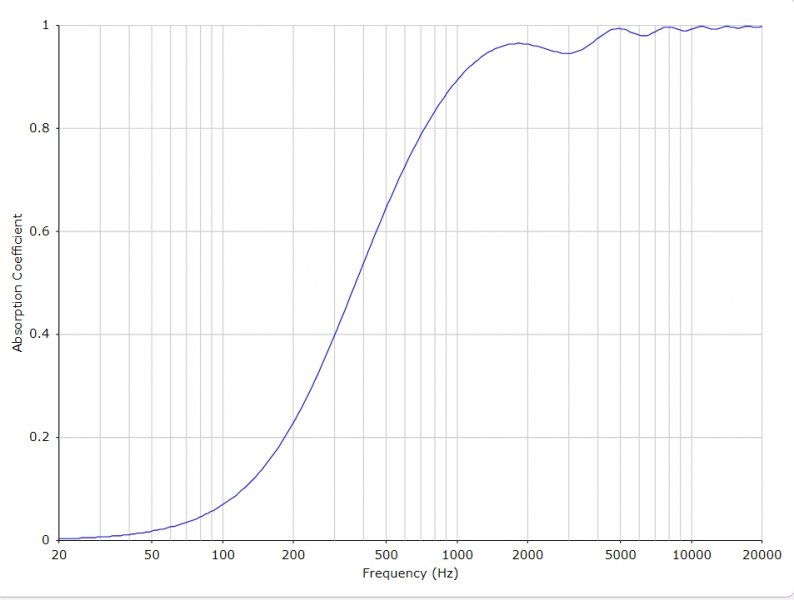
Ideally you want to treat specular reflections evenly down to the Schroeder frequency.
100% agree. The panels I use are 6" thick. Corner traps are 2 ft X 2 ft.Yes. It's best to experience this rather than simply concluding based on some researchers. After all, there are many variables that come into play here.
I highly recommend using broadband treatment. A 2" thick absorber will only absorb really well down to approximately 600-700 Hz area.
View attachment 75080
Ideally you want to treat specular reflections evenly down to the Schroeder frequency.
What gas flow resistance did you use for the OC703? 20,000?
I simulated with 23 000 Pa.s/m2. Green graph is with 16 000 Pa.s/
Here is an interesting fact I don't think most people are aware of. Up to about a 4" (100mm) the rigid fiberglass (such as OC703) is good. But once that panel gets beyond 4" then the fluffy insulation is actually better. Here is an example comparing rigid vs fluffy that is 6" thick.
But then again, most people think a 4" panel is thick.
Attachments
I have been fascinated with crosstalk elimination but never have found a way to practically implement it into a permanent listening situation. Using extra drivers or digital processing has always colored the sound too much for me, and using a divider panel is just plain impractical. I'm interested in the idea of a sophisticated stereo upmixer that can mix two channel into a 3 or more across the front configuration without degrading the quality. That would allow wide speaker positioning without holes in the soundstage. So far the only good results I've heard have been from stuff mixed originally to more channels, but if our ears can do it it seems good enough software should be able to determine the panning of sounds in a 2 channel mix and send it cleanly to the appropriately placed speaker.I heard these Polks at RMAF 2019... it seems to me the main advantage is the spacing between speakers is much less critical. In some circumstances this is a major advantage! The system's soundstaging and imaging was impressive but it's a narrow sweet spot. The Polks performance overall was better than expected but the tweeters are not that great, imo. Overall it was a cool demo but didn't have me looking into crosstalk elimination afterwards.
Unrelated to crosstalk, but if the recording has enough spatial cues and they make it through the speakers, the need for anything else seems to be reduced accordingly. If the spatial cues are from the recording instead of reflections, they can more convincingly portray the recording space. Personally, I like a greater proportion of direct sound but also the system needs to be capable of pretty high resolution to achieve a 3-D, immersive soundstage. I've also found that wider spacing between speakers helps.
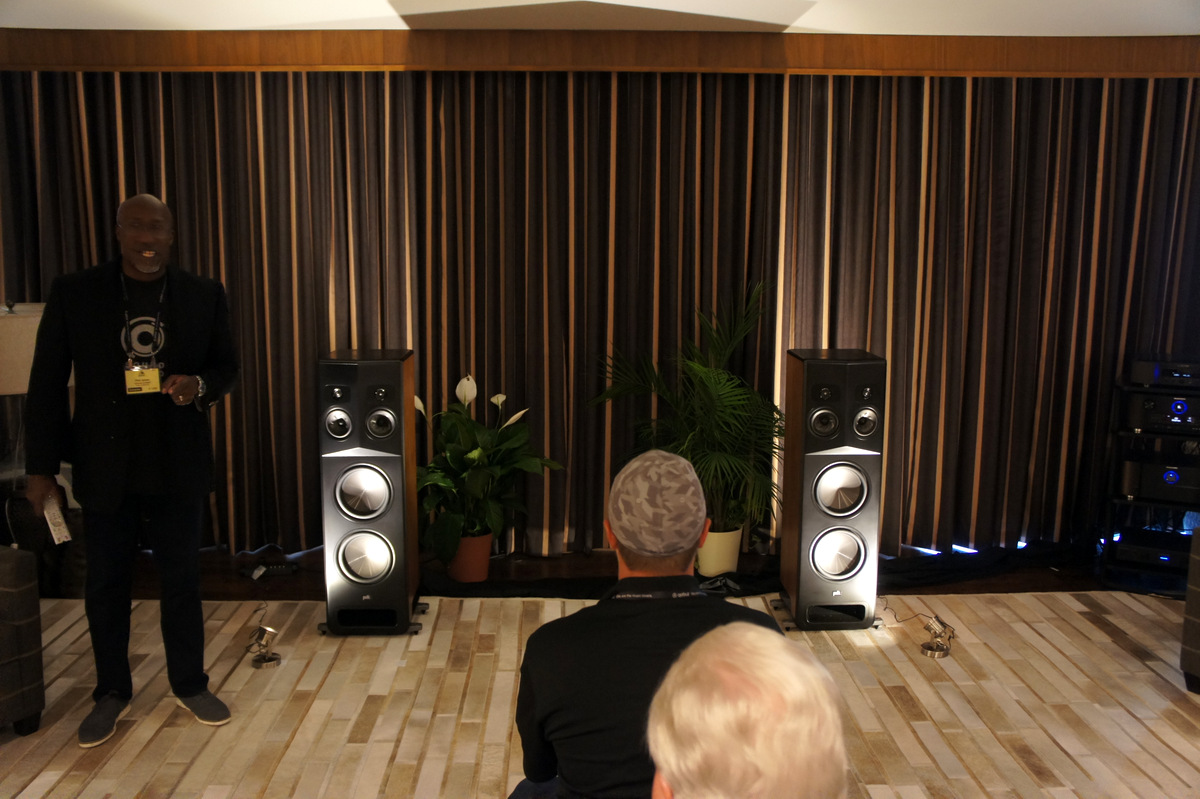
All that being said, I'm pretty happy with the standard 2 channel setup and appropriate room treatments to tighten the bass and adjust early reflections to suite preferences. My own simple experiments with creating multi channel mixes and then downmixing them to stereo got me thinking that adding extra channels was a lot of work for a subtle
Good headphones don't sound dead to me like an overdamped room but the external imaging is non existent. The soundwaves need to travel across the head and ear and adjust accordingly to small head movements to be convincing. Now that I've learned to EQ a couple of my headphones reasonably well I do find headphone listening to be quite pleasurable but it's a separate kind of experience. I agree that the degree of ambient information embedded in the recording has an effect on how much room reflections are desirable. I've found playing with horns of various dispersion that close mic vocals can sound great with a really wide dispersion horn, but complex symphonic work recorded in ambient spaces sounds best to me with extremely narrow dispersion horns. The narrow horns were also able to create a full 180 sound stage at times. I've settled with an intermediate dispersion with good off axis response. Amazingly I haven't changed anything in months now!
The sound enters each ear separately and nothing acoustical travels across the head. Also, are you using head tracking to compensate for head movement? If so, how are you doing that?The soundwaves need to travel across the head and ear and adjust accordingly to small head movements to be convincing.
Yes, understood. We don't need anything acoustical to travel across the head to get spaciousness - just decorrelation between left and right ears, which headphones can easily produce. I should add that this can't be just any decorrelation but a decorrelated signal that is similar enough to be recognized as the same sound. Two different people speaking in each earpiece won't produce spaciousness. But because we don't have sound traveling across the head the HRTF doesn't work, so head tracking and appropriate custom equalization is typically needed to get a convincing external imaging effect. I don't get external imaging with my headphones but I do get excellent tonality with some basic EQ, and it doesn't sound to me like I'm listening to speakers in an overdamped room, even though it's a near perfect anechoic listening experience. It sounds open and lively, and I'm assuming that's because of the lack of crosstalk allowing adequate left to right decorrelation. I know some people prefer to add crosstalk to their headphone listening. I've tried that and I don't like it. To me it flattens and dulls the sound and does remind me of an overdamped room. Listening in mono is not great on headphones either but my expectations are usually pretty low with mono.The sound enters each ear separately and nothing acoustical travels across the head. Also, are you using head tracking to compensate for head movement? If so, how are you doing that?
Similar threads
- Replies
- 60
- Views
- 3K
- Replies
- 53
- Views
- 3K
- Replies
- 13
- Views
- 2K
- Replies
- 19
- Views
- 929
- Replies
- 0
- Views
- 168


